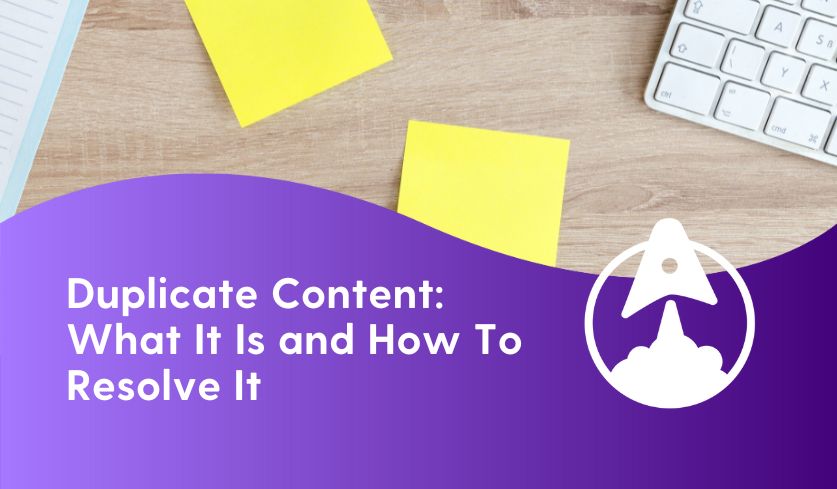There’s a possibility that your web content exists at more than one URL on your website, even if unintentionally. This is especially true if you service customers in multiple locations or offer the same services to multiple industries. This duplication is more than a unique quirk of creating internet content – it can also negatively impact your search engine visibility. Below, we’ll guide you through duplicate content in SEO and how you can easily minimize its negative impacts.
What is duplicate content in SEO?
In SEO, duplicate content is content that readers can access on multiple URLs. For example, the URL for your hiking shoes’ product page is yourwebsite.com/product/shoes/brown. However, the URL yourwebsite.com/product/shoes/gray appears when you switch the shoes’ color from brown to gray. The latter URL’s content is thus a duplicate of the former even though both pages otherwise appear exactly the same.
The term “duplicate content” also encompasses two web pages that, though not exactly the same, are extremely similar. For example, let’s say you run an accounting firm with offices in New York, Los Angeles, and Chicago. Let’s also say that each city’s pages on your site include exactly the same text, but with the city name swapped out accordingly. Since the pages are otherwise identical, this qualifies as duplicate content in SEO.
How does duplicate content in SEO affect your site?
Duplicate versions of your web content can lower the original content’s visibility in search results. This is because search engines typically don’t include multiple pages that are all the same among their results. Instead, search engines will automatically choose one URL for the content to prioritize in its rankings — unless you tell search engines which URL to rank.
This matters because other websites linking to your content may unknowingly link to a duplicate page. For example, maybe they link to the latter instead of the former:
- https://yourwebsite.com/page
- https://m.yourwebsite.com/page (your page’s mobile version if different than its desktop version)
This spreads your original page’s number of inbound links (links to your content from other websites) across several URLs. The result is lower search engine rankings – inbound link quantity and quality are direct factors in how high your webpages rank. This is important because the top result’s average click-through rate is 27.6%, which is 10 times higher than the 10th result.
Reasons why you may have duplicate content
You might have more than one version of the same piece of content for the following reasons.
Enabling mobile support
The desktop website https://yourwebsite.com is a separate page from the mobile version https://m.yourwebsite.com. However, assuming these two URLs display the same content (just in a different format), you’re looking at duplicate content.
Adding multiple content tags
If you tag your blog posts in several categories, you might be generating duplicate content depending on your blog system. For example, let’s say that you’ve set up tags across your blog for “payroll,” “HR,” and “retirement.” Let’s also say your blog on paycheck deductions to fund employee retirement plans is tagged as both “payroll” and “retirement.” Depending on your blog’s settings and your website content management system (CMS), this might generate two URLs that constitute duplicate content:
- https://yourwebsite.com/payroll/employee-retirement-paycheck-deductions
- https://yourwebsite.com/retirement/employee-retirement-paycheck-deductions
You could also encounter this problem if your website’s product pages generate a different URL every time visitors toggle the product options. For example, switching between a 16-foot LED light strip and a 32-foot option on the same page could alter the URL. Duplicate content is, again, the result.
Syndicating your content
Certain news websites may arrange for other outlets to republish their content word for word. This is known as syndication, and it’s great for exposure. It’s also another form of duplicate content in SEO.
A common example is seeing articles on MSN or Yahoo that, toward the top, show the logo of another news outlet. This means the article exists on two different websites, yielding multiple pages that are the same and thus duplicate content. (A key point here: Duplicate content can describe identical content hosted on two different domains, a.k.a. websites.)
Sometimes, other websites will copy your content without a syndication agreement. The duplicating website is known as a scraper. If someone scrapes your content, it can hurt your original content’s search engine rankings. And unfortunately, the fact that you never permitted this duplication isn’t a factor. You’ll have to do the work to disavow these scrapers and possibly enforce your copyright against the site publisher.
Creating printer-friendly content
Including printer-friendly options for your web pages can result in duplicate content if these options result in URL changes. For example, let’s look at the below URL again:
- https://yourwebsite.com/payroll/employee-retirement-paycheck-deductions
A printer-friendly version of this page might require a separate URL to accommodate all the changes needed to ensure printer-friendliness. This second URL might appear as follows:
- https://yourwebsite.com/print/payroll/employee-retirement-paycheck-deductions
As such, your content now has two homes on the internet, leading to duplicate content on your site.
Using several URL prefixes
Most websites will be accessible via four prefix options: http://, https://, www., and simply yourwebsite.com with no prefix. Technically, each of these options is a duplicate URL for your content.
There’s an easy solution for preserving your search visibility. You can set which option (“www” or no “www”) is the preferred URL for Google to crawl and rank via Google Search Console.
How do you know if your site is affected by duplicate content?
Below are three ways to find duplicate content on – and beyond – your website.
1. Siteliner
After you enter your website name on Siteliner, the platform will show you circle graphs detailing your percentages of duplicate, common, and unique content. You can then pull up a list of all your duplicate content and see each URL’s number of match words and match pages. You can also see the match percentage and page power. When you click on a URL, Siteliner will clearly highlight the duplicate portions of your content.
2. CopyScape
You can use CopyScape to find duplicate content on other websites. This is a great way to identify scrapers, whom you can contact with a request to remove or adjust the content. Although these parties are not always obligated to respond, a request helps you start somewhere before escalating the issue.
3. Google quotation search
Let’s say a certain page of yours has been experiencing heavy traffic. It’s entirely possible some of this traffic could be coming from scrapers looking to seize on audience interest in the page’s topic. To find out, you can place a phrase from your content inside quotation marks and search Google for it. This quotation search will bring up any and all web pages with identical phrasing.
Four solutions for resolving duplicate content
It’s typically not too difficult to ensure that duplicate content has minimal effects on your content’s search engine visibility. Here are three common solutions.
1. Redirect the content
Through a 301 redirect, you can ensure that Googlebot (Google’s ranking algorithm) only considers your original content when ranking search results. Take the below two links as an example again:
- https://yourwebsite.com/payroll/employee-retirement-paycheck-deductions
- https://yourwebsite.com/print/payroll/employee-retirement-paycheck-deductions
If you add a 301 redirect to the latter, Googlebot will know not to assess that page, a.k.a. “crawl” it. Instead, the bot will assess and rank only the former URL, which is the original content. This means that Google users will only see your original content. As such, other websites linking to your content will likely link to only your original content, increasing its “link equity,” a key SEO factor.
2. Use canonical URLs
A canonical URL is the one Google will designate as most representative of all versions and duplicates of the content. This means that all the other versions’ “ranking power” will instead go to the original page. As such, the original page will rank as highly as possible.
To again use the below examples, the first will make more sense as a canonical URL since it’s the original content.
- https://yourwebsite.com/payroll/employee-retirement-paycheck-deductions
- https://yourwebsite.com/print/payroll/employee-retirement-paycheck-deductions
Google will determine your content’s canonical URL if you don’t share your preference, and it might not always choose the URL you’d like. You can use a “rel=canonical” tag to tell Google which URL to make canonical. For example, in the former page’s HTML head, you can include the below tag.
- <link href=”https://yourwebsite.com/payroll/employee-retirement-paycheck-deductions” rel=”canonical” />
This tag will tell Google that the original page should be the canonical one. However, Google can still choose another page – this tag just minimizes the likelihood of it choosing any page besides what you’ve designated.
3. Rewriting the content
If your duplicate content is the result of using the same copy on two or more web pages, rewriting the content is your smartest move. You should replace the current copy with entirely original language from top to bottom. This can be a time-consuming undertaking if writing isn’t your primary service, but rest easy – content writing agencies can handle this entirely on your behalf. This elimination of duplicate content in SEO is only the start of how a content writing agency can improve your web presence.
4. Make sure your site is mobile friendly
If your duplicate content issues stem from desktop and mobile-friendly versions of your site, it’s time to invest in a new site. The best sites are responsive, or in other words, they seamlessly shift from desktop to tablet to mobile versions without the need to create new or special pages. This way, users can easily browse your website from any device without you generating duplicate content. The web’s been moving in this direction for years, and if your site isn’t mobile-friendly by now, it’s time to fix that, stat.
Address duplicate content on your website with SCS Creative
In some cases, the duplicate content harming your website’s search visibility is simply a matter of similar language across your pages. If so, you’ll need to rewrite each page, and that can require ample time and work, so why not outsource this effort? At SCS Creative, we spend our days working on these projects and all other types of content writing.
Through our humans-first SEO content writing approach, we create web content full of serious, high-quality information. With an award-winning former journalist leading our team, we give old content new life and write new content that arrives in tip-top shape. We can rewrite your duplicate content and then build you a long-term content strategy that skyrockets your search engine visibility. Our work is known to tremendously multiply your website impressions, the number of keywords for which you rank, and your number of page-one placements.
Duplicate content is a challenge, but it can also be the start of a gradual journey toward a strong web presence that boosts your sales. It’s a journey we’ve helped all kinds of clients take, and we’d be thrilled to walk that path with you too.







